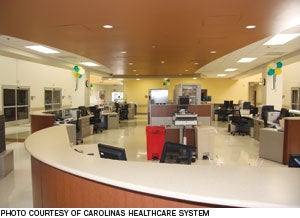Are freestanding emergency departments a cure for crowding?
 |
| A nurses' station at the CMC-Steele Creek freestanding emergency department in Charlotte, N.C., is surrounded by patient-treatment rooms. |
The number of hospital-based EDs has declined by 27 percent over a 20-year period ending in 2009, while the number of visits to hospital EDs increased to an all-time high of 123 million in 2008, states a recent report by the Journal of the American Medical Association.
It's no surprise that in 2007 emergency rooms at about half of U.S. hospitals operated at or beyond capacity, according to an American Hospital Association (AHA) report. To cope with the demand for emergency service, hospitals in at least 16 states have opened freestanding EDs, the California HealthCare Foundation reports.
In 2009, there were 241 community hospital-affiliated freestanding EDs, or 5.9 percent of all community hospitals, according to the AHA. That's an increase of about 25 percent over the 179 freestanding EDs operated by community hospitals in 2006, say AHA officials.
While freestanding EDs originally functioned as a way to serve patients in rural or inner-city areas that can't support a full hospital, hospitals typically are opening new facilities in urban or suburban areas. The purpose is twofold: It can improve emergency care by reducing patient wait times plus it helps the hospital market its brand and capture new patients.
Carol Lovin, president of Carolinas HealthCare System (CHS) Management Co., Charlotte, N.C., says the company began studying the viability of opening freestanding EDs in 2004. The system operates 32 hospitals in North Carolina and South Carolina.
"There were two reasons that we looked at this and thought the freestanding emergency department strategy made a lot of sense," Lovin says. "One of them was to offload the capacity of our current emergency departments. The other and equally important reason was to give people in these communities an opportunity to go to a CHS emergency department."
CHS opened a freestanding ED in Charlotte in November 2009, and the response has far exceeded expectations, she says.
"In 2010, we had almost 20,000 patient visits at the facility. That was double what we projected," she says.
CHS plans to open three more freestanding EDs in the Charlotte area over the next nine months, Lovin says.
Jesse Pines, M.D., director, Center for Health Care Quality and associate professor, emergency medicine and health policy at George Washington University Medical Center, Washington, D.C., sees the growth in freestanding EDs as a mostly positive development for patients.
"Freestanding emergency departments tend to be very successful, which indicates many patients find value in the service, which is sometimes faster than regular emergency departments," Pines says.
"Fast 24/7 comprehensive medical care is what many Americans want and is precisely what freestanding EDs deliver," he says.
Emily Carrier, M.D., senior health researcher at the Center for Studying Health System Change, Washington, D.C., who also serves as an emergency care physician, says freestanding EDs can serve a useful purpose.
On one hand, they add capacity and reduce patient wait times in areas where hospital emergency rooms are overcrowded, she says.
But because hospitals tend to open freestanding EDs to gain market share in areas already served by other health care facilities rather than in underserved rural or inner-city communities, Carrier also is leery of the trend.
"If you're bringing down the wait time in the EDs in your community from four hours to two hours, everyone would agree that that's a good thing," Carrier says. "If you're bringing the wait time down from 15 minutes to 12 minutes, that's maybe a little more difficult argument to make."




